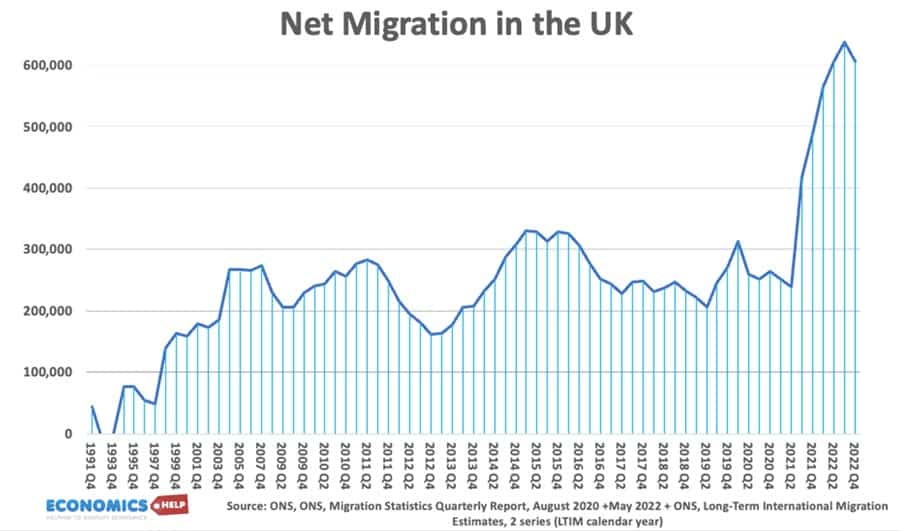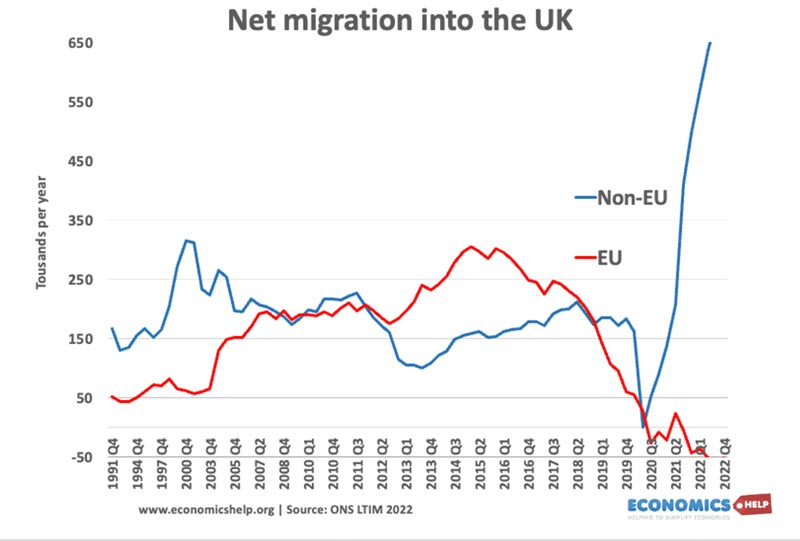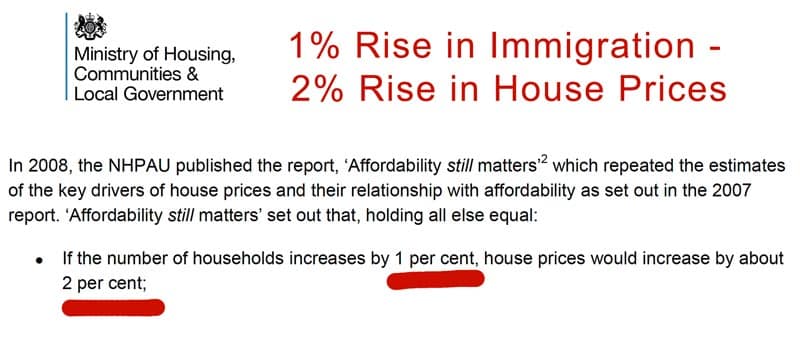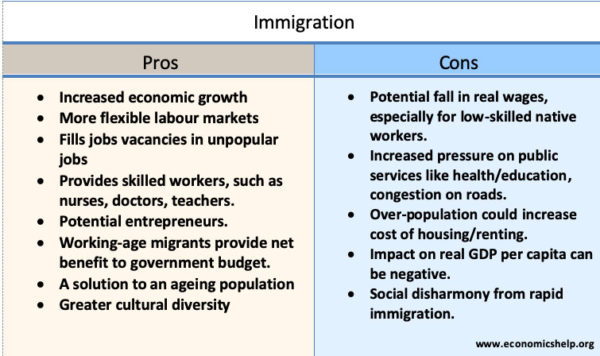Last year, the UK saw a record level of net immigration, 600,000 – and although last year was exceptional, it is forecast to remain above pre-Brexit levels until 2026. Last year was also a year of record rent rises and chronic housing unaffordability. Given the UK’s inability to meet housing targets, how much is immigration worsening the UK’s housing crisis?
If we wish to make housing more affordable, do we need to choose between building a lot more homes or reducing immigration?

But, firstly, it is important to understand what is actually happening to immigration levels. When the UK left the EU in 2021, free movement of labour ended and as a result, EU migration has fallen significantly. However, there has been a very significant rise in non-EU migration.

The bulk of this increased migration is from work visas and student visas. The figures of 2022 have also been boosted by 174,000 arrivals from the Ukraine, likely to be a one-off event. Last year was also exceptional because of the sharp rise in student visas, due to the ending of Covid. In the next few years, net migration levels are forecast to fall, but importantly still remain very high. The last census of 2021 found that 57% of the rise in the UK population was due to net migration, with 10 million foreign-born people, among a population of 59.5 million in England and Wales.
As a side note, the number of illegal immigrants detected arriving on small boats across the channel was 46,000 people in 2022, a tiny fraction of overall housing demand, though it has placed costs on local councils.
The rise in net migration has increased housing demand and is one of the largest components of rising numbers of households. This is especially acute in the rented sector as recent migrants are much more likely to be in the private rented sector than home ownership. Levels of migrants with subsidised social housing are similar to rates of native-born people.
Since the early 1990s, the average price of housing in the UK has soared. Real prices have risen faster than similar European countries, and in late 2022 reached nearly nine times that of average incomes. Rents have also risen and combined with low wage growth, put upward pressure on housing costs as a share of income. But, the big question is to what extent can this housing crisis be attributed to migration levels?

In 2018, the Ministry of Housing, Communities and Local Government used a model from the University of Reading, suggesting a 1% rise in households led to 2%, rise in house prices. Therefore, the 4.8 million increase in foreign-born households between 1991 and 2016, means immigration could be responsible for an estimated 21% increase in house prices over this period.
Now, If this model is true, in 2022, with a net migration figure of 600,000 being about 1% of the UK population, this suggests that net migration is responsible for house price inflation being 2% higher than otherwise. In the past 12 months house prices have fallen 5%, in the absence of net migration, this could have been house price inflation of -7%
However, there are a number of caveats to this analysis.

Firstly, this study used by the government is on the more extreme edge of the impact of migration on house prices. The Migration Observatory, point to three studies which suggest a relationship between immigration and housing is closer to 1% rise in immigration levels leading to a 1% rise in house prices and rents.
With a UK population of 67 million net migration of around 300,000 per year (0.4%) could be putting up annual prices by 0.4% per year. Not much, but it would be compounded over time.
Also, there are other things to bear in mind, in the UK average household sizes have fallen to 2.34. However, recent migrants tend to have lived in greater housing density.
Also, on a very local level, studies suggest that highly concentrated levels of immigration can actually lead to lower house prices in those local authorities because it leads to high-income homeowners moving out. On the other hand, migration has been greatest in London, but London is also one of the regions with the most inelastic supply.
Another factor is that although the UK is very bad at building homes, one constraint to building new houses is a shortage of skilled labour. The UK is good at producing graduates, but not bricklayers. Industry has called for more migration of construction workers to help build houses.
Another factor is that since a high share of net migration is from student visas, the impact on the student renting sector is greater. And in recent years, the cost of student rents has been soaring.
All studies state that it is difficult to provide an exact answer to the question of how much immigration affects house prices and rents – because there are so many moving factors, there are many different studies with different outcomes. However, the more unresponsive supply is, the bigger impact migration has.
However given the UK has a widely accepted shortage of housing – it has one of the lowest levels of home vacancies in Europe, very high levels of net migration are at the very least going to exacerbate upward pressure on national prices and rents. But, to give a sense of perspective – how does the effect of migration compare to say other factors, like supply, real incomes and interest rates?
A study by Hilber and Vermeulen (2014) suggested house prices in England would have risen by about 100 percent less, in real terms, from 1974 to 2008 (from £79k to £147k instead of to £226k) if, hypothetically, all regulatory constraints were removed”. But, this is very hypothetical, as there is no political interest in removing all regulatory constraints. But the Migration Advisory Committee study found that the impact of migration on house prices was larger in local authorities with more restrictive planning practices.
A much bigger factor than immigration in driving house prices in recent years has been ultra-low interest rates. Between 2009 and 2022, this distorted the market causing a rise in price-to-income ratios. Despite very weak real income growth in the period 2009-22, house prices soared as mortgages were historically cheap. As interest rates have risen drastically, prices have started to fall, though the modest declines, suggest both interest rates take time to have effect, and other factors are at play.
Given most of the recent migration end up in the privately rented sector, the impact of migration is bigger in private rents, rather than house prices. It is a real problem that the supply of private rented accommodation is not keeping up with demand. This has led to an increase in both rents and difficulty securing any property.
A good question is that if immigration is placing more pressure on housing, why is it so high and why does even a Conservative government who placed great emphasis on reducing immigration, allow it to increase? One answer is that business is very keen to have access to labour, to fill labour shortages. The UK labour market has struggled with rising long-term sickness and a decline in labour participation. Migration keeps the economy going. On the one hand, immigration places more pressure on the NHS, but without immigration, the NHS would be even more severely understaffed. 16.5% of NHS staff report nationality other than British. With a lack of trained nurses and doctors, we rely on immigration to fill vacancies.
The economic impact of migration on wages and economic growth is worth a separate video. But, one point is that the UK, like most other European countries has a declining birth rate, immigration of young skilled workers help to offset the demographic decline. Working migrants tend to be net contributors to the Treasury, because they pay income tax, but don’t receive pensions. In a crude way, you can argue immigration plays a role in paying for an ageing population.

But, if we were to weigh up the pros and cons of net migration. On the disadvantage side, we can definitely make a good case, that high levels of net migration will exacerbate housing costs. At least in a country, which struggles to get anywhere close to building housing targets.
At the same time, it would be a mistake to label immigration as the biggest cause of the housing crisis. House prices are driven by interest rates, real income and supply. Immigration is a factor behind demand but is superseded by interest rates and real incomes. Even if we cut immigration sharply in the next few years, the impact on prices and rents would take time to be noticed. However, immigration does have a reasonably large impact on the housing market and it is the young, low-income population who are most affected.
Related
